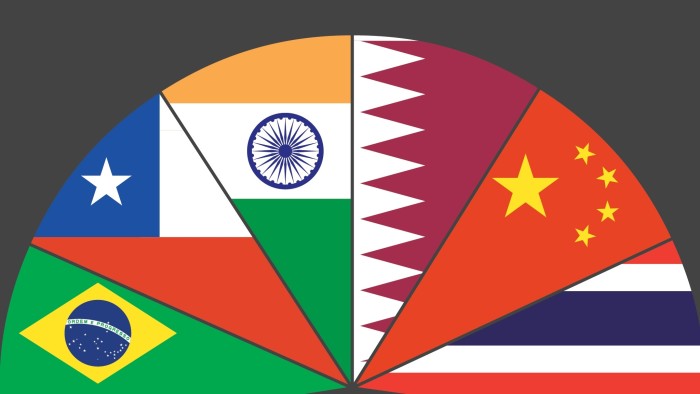Redefining EM: Matrix offers new perspective on definition

Roula Khalaf, Editor of the FT, selects her favourite stories in this weekly newsletter.
The challenge facing today’s emerging market investors is to discern order — or at least pattern — among a great diversity of different countries, assets, risks and opportunities. Some attempts have been made to group countries that seem to share attributes, such as the Brics (Brazil, Russia, India and China). But any static grouping inevitably loses relevance over time. A more dynamic system is called for, but one that continues to find order even as EM growth trends ebb and flow.
This is the thinking behind shifting “from Brics to Blocs”, a matrix for EM investing.
The system is organised around the two defining distinctions of emerging market economies: whether they run structural current account deficits or surpluses and whether they are primarily exporters of commodities or manufactured goods.
This classification generates a 2x2 matrix that divides EM countries into four quadrants — or “blocs” (see table). Each bloc groups countries with similar characteristics with the result that a country’s location in the matrix is a good predictor of what its economic fate will be under specific phases of the global economic cycle.
Two big forces — tides causing the fortunes of EM countries to ebb and flow — drive the EM economic cycle: global liquidity and commodity demand. And each of these two tides is almost entirely dependent on the waxing and waning of one of two dominant moons orbiting the world of emerging markets. The US moon is the main gravitational force behind the liquidity tide, the Chinese moon is that behind the commodity tide.
One glance at the quadrant reveals that the south east bloc is the cornerstone of the EM asset class: over half of the MSCI EM index is located there. Built around a China core, it also includes most of east and southeast Asia (though not commodity-rich Indonesia). In addition to the tech-rich Israel, it also includes Slovenia, Slovakia and Hungary, which are becoming integral to the German supply chain in the same way that east Asia feeds the Chinese supply chain.
The countries in this quadrant are increasingly high added-value and even high tech in their export profile; a combination of robust external accounts and high foreign exchange reserves leaves them essentially self-financing and so not keenly exposed to the global liquidity cycle. For investors, these attributes make the south east bloc the lowest both in terms of capital preservation risk and volatility.
By contrast, the most risky and volatile quadrant for investors is the north west bloc, host to deficit-running countries that export primarily minerals and agricultural products. Most countries in this bloc partied hard when commodity prices were robust and liquidity was plentiful but neglected the deeper damage to their economies done by the dreaded Dutch Disease. South Africa is a typical example of this bloc: carry-seeking bond inflows strengthened the rand, helped puncture inflation, permitted interest rates to fall and so facilitated a “consumption-cart-before-production-horse” mode of economic growth. The unintended yet devastating consequence has been widespread deindustrialisation.
FT Series

As emerging markets overtake developed ones in some areas the FT investigates whether it is time to coin a new phrase for the developing powers
The north east bloc is also commodity exporting, indeed it is essentially oil-exporting. And while it is a hostage to the commodity cycle, that the likes of Greater Arabia and Russia tend to run current account surpluses means that this bloc is less exposed to the ebb and flow of liquidity.
Finally the south west bloc is composed of the deficit-running, manufacturing exporters — the ‘maquiladoras’ of Mexico supplying the US and eastern Europe and Turkey supplying western Europe. In addition, service-rich India is located in this bloc. As recent events have shown, they — as importers of commodities — have benefited from the end of the commodity supercycle but — as deficit runners — have been negatively impacted by the retreating liquidity tide.
Michael Power is strategist at Investec Asset Management.
Follow us on Twitter @em_sqrd
Comments